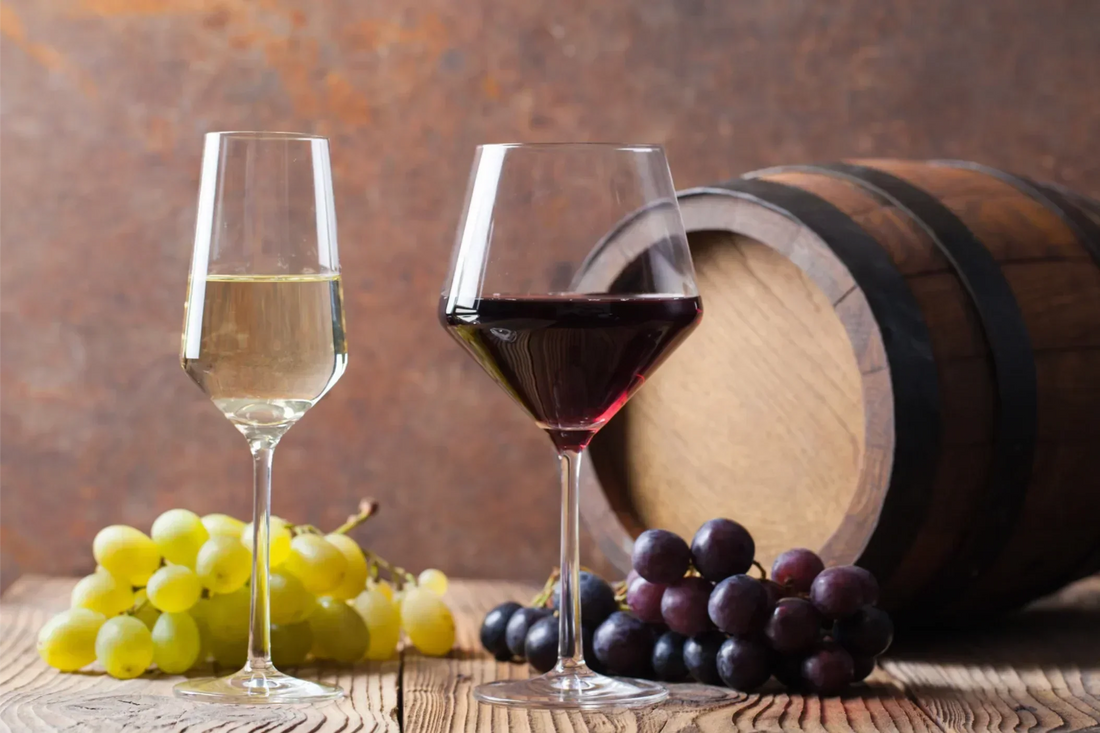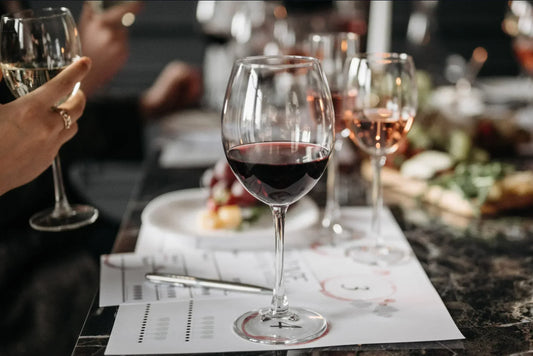
Red Wine vs White Wine: What’s the Difference?
As wine newcomers, you may wonder, "What is the real difference between red and white wine?" While colour is the most obvious distinction, these two types of wine also differ in grape varieties, winemaking techniques, flavour profiles, body, tannins, acidity, and suitable food pairings. In this guide, we explain the main differences between red and white wine with expert insights from viticulture and winemaking.
What Is the Main Difference Between Red and White Wine?
| Red vs White Wine: Quick Comparison Table | ||
|---|---|---|
| Aspect | Red Wine | White Wine |
| Grapes Used | Made from dark‑skinned grapes such as Cabernet Sauvignon, Merlot, Pinot Noir, Syrah/Shiraz. | Made from light‑skinned grapes such as Chardonnay, Sauvignon Blanc, Riesling, Pinot Grigio. |
| Winemaking Process | Fermented with skins, seeds, and sometimes stems (maceration). | Skins removed before fermentation. |
| Ageing Method | Often aged in oak barrels for added complexity, spice, and smoothness. | Usually aged in stainless steel to preserve crisp fruit flavours (some styles use oak for richness). |
| Colour | Deep red, ruby, or purple; can range from light garnet to almost black. | Pale yellow to golden; can be straw‑coloured or amber in special styles. |
| Flavour Profile | Rich, robust, with notes of berries, plums, spices, herbs, or earthy tones. | Light, crisp, with notes of citrus, green apple, peach, pear, or tropical fruit. |
| Tannins | High tannin content from skin contact → dry, structured mouthfeel. | Low to no tannins → smoother, softer texture. |
| Acidity | Low to moderate acidity. | Higher acidity for a fresh, zesty taste. |
| Food Pairing | Best with hearty dishes like steak, lamb, mushroom risotto, aged cheese. | Best with lighter dishes like seafood, roast chicken, creamy pasta, soft cheese. |
| Ageing Potential | Ages well due to tannin structure, developing complex flavours over time. | Generally enjoyed young, though some oaked whites can age well. |
What Grapes Are Used to Make Red and White Wine?
When it comes to grapes, red and white wines each have their unique origins, starting with very different skins. Red wines are typically crafted from dark-skinned grapes like Cabernet Sauvignon, Merlot, Pinot Noir, and Syrah/Shiraz. These grapes are rich in tannins and pigments that lend reds their deep colour and full body. On the other hand, white wines are primarily made from lighter-skinned grapes such as Chardonnay, Sauvignon Blanc, Riesling, and Pinot Grigio, offering a gentler colour, refreshing acidity, and lively fruit flavours.
For example:
- Red wine grapes: Cabernet Sauvignon, Merlot, Pinot Noir, Syrah/Shiraz, Zinfandel.
- White wine grapes: Chardonnay, Sauvignon Blanc, Riesling, Pinot Grigio, Chenin Blanc.
How Are Red and White Wines Made Differently?
The main difference between making red and white wines lies in the skin contact during fermentation. Red wines are fermented together with their skins, seeds, and sometimes stems, a process called maceration. This process imparts their rich colour, tannins, and deep flavours. Conversely, white wines typically have their skins removed before fermentation, resulting in a lighter colour and a fresher taste. Additionally, the ageing methods differ. Reds often spend time in oak barrels to develop spiciness and smoothness, while whites are usually kept in stainless steel to maintain their crisp fruitiness.
Typical winemaking methods:
- Red wine: Fermented with skins (maceration), often aged in oak barrels for complexity.
- White wine: Skins removed before fermentation, usually aged in stainless steel for freshness.
What Do Red and White Wines Taste Different?
Red and white wines each have their unique charm in the glass. Red wines often feel richer and more full-bodied, with lovely flavours of berries, plums, spices, or earthy undertones. The tannins from the grape skins add a slightly dry, grippy texture that enhances the experience. On the other hand, white wines tend to be lighter and crisp, with bright citrus, green apple, or tropical fruit flavours, complemented by lively acidity that makes every sip feel refreshing and zesty.
Typical flavour profiles:
-
Red wine:
- Light reds: Strawberry, raspberry, cherry.
- Full-bodied reds: Blackberry, plum, blackcurrant, plus hints of spice or tobacco.
-
White wine:
- Light whites: Lemon, lime, green apple.
- Fuller whites: Peach, pear, tropical fruits, sometimes with buttery or nutty notes.
Love red wine but want something portable and picnic-ready?
👉 Discover our top picks in 8 Best Canned Red Wines to Try (2025 Edition), rich flavour, no corkscrew needed.
Difference in Tannins and Acidity Between Red and White Wine?
Tannins and acidity play such important roles in shaping the taste and mouthfeel of wine. Typically, red wines tend to have a richer tannin content because they’re fermented with grape skins and seeds, giving them that lovely dry, slightly puckery sensation. Plus, tannins help reds age beautifully over time. On the other hand, white wines usually have little to no tannins since the skins are taken out before fermentation, but they often boast higher acidity, making them wonderfully crisp and refreshing.
Key differences:
- Red wine: High tannins, moderate acidity → fuller body, smooth or firm texture, longer ageing potential.
- White wine: Low tannins, high acidity → light, zesty, and refreshing taste.
Craving something crisp and refreshing on the go?
👉 Check out 7 Best Canned White Wines to Try (2025 Edition) for bright, zesty favourites perfect for any occasion.
Which Foods Pair Best With Red and White Wine?
Pairing wine with food is an experience that comes down to matching the weight and flavour intensity of both. Red wines, with their richer body and tannins, beautifully complement hearty, savoury dishes like grilled meats, roasted vegetables, and aged cheeses. On the other hand, white wines, lighter and more acidic, shine when paired with fresher, more delicate foods such as seafood, poultry, and crisp salads. The main aim is to let both the wine and the food enhance each other, creating a harmonious balance of flavours.
Classic pairings:
- Red wine: Steak, lamb, mushroom risotto, pasta with tomato-based sauce, cheddar or gouda cheese.
- White wine: Grilled fish, roast chicken, creamy pasta, fresh salads, brie or goat cheese.
Not sure which bottle to open for tonight’s dinner?
👉 Read our easy, beginner-friendly guide - Wine Pairing 101: Simple Rules for Matching Wine and Food Perfectly.
Conclusion
In the end, choosing between red and white wine is about more than just colour. It’s about the different grapes, winemaking styles, flavours, tannins, and perfect food matches. Whether you prefer rich reds or light, refreshing whites, trying both is the best way to find what you enjoy.
FAQ
1. Can you make white wine from red grapes?
Yes. Most grape juice is naturally clear, so if the skins are removed before fermentation, white wine can be produced from red grapes. Blanc de Noirs Champagne is a classic example.
2. Why does red wine have more tannins than white wine?
Red wines are fermented with their grape skins and seeds, which are rich in tannins. White wines contain little to no tannin because the skins are removed before fermentation.
3. Which is better for beginners, red or white wine?
Many beginners find white wines easier to enjoy initially because they’re lighter, more refreshing, and lower in tannins. Soft, fruity reds like Pinot Noir can also serve as an excellent starting point.
4. Does red wine always have more alcohol than white wine?
Not necessarily. Alcohol content depends on grape ripeness and fermentation choices so that some white wines can have as much or more alcohol than certain reds.



